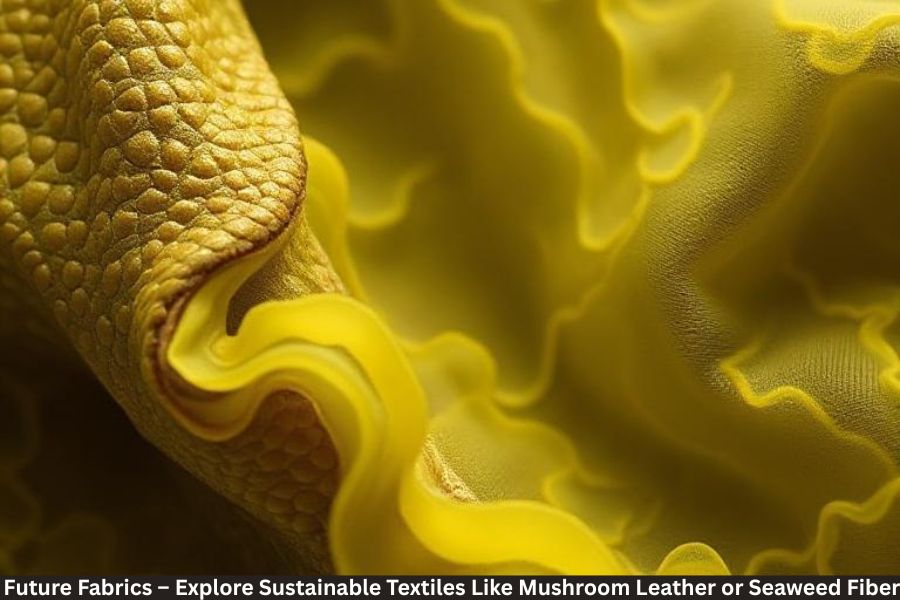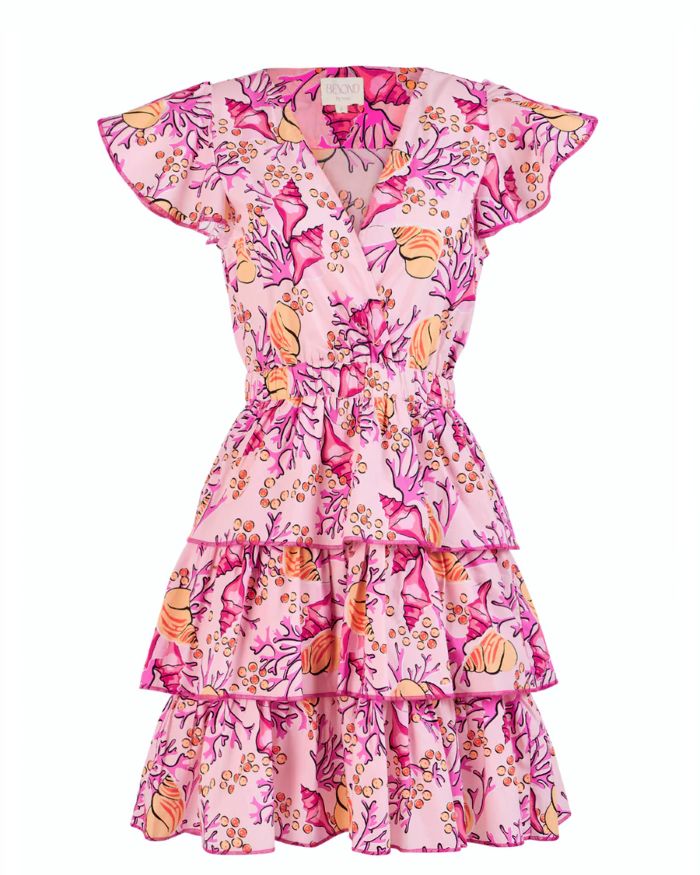The future of fashion brands itself as green, innovative, and sustainable. Conventional textiles have always borne with them an environmental baggage-water-intensive cotton, fiber-intensive synthetic, and leather-intensive resources of nature. Future fabrics: The New Textile Revolution of Mushroom Leather, Seaweed Fiber, and Upcycled Materials-the next generation of textiles that promise style without compromise.
Sustainable textiles are no longer a trend—they are a need for an eco-friendly fashion industry.
The Evolution of Fabrics
In times of yore, humans needed to be creative to provide textiles; they started with animal hides and then cotton, wool, and synthetics. Yet each attempt to develop imposed an environmental cost. Today designers and scientists are joining forces to create fabrics that are beautiful and chemical for humans.
Significance of Sustainable Textiles
Fashion accounts for roughly 10% of all carbon emissions worldwide. While future fabrics aim to lessen this footprint, they also seek to provide durable, stylish alternatives.
Understanding Future Fabric
Definition and Importance
Future fabrics are textiles which are created with sustainability at their center. They use renewable resources, minimize pollution, and often biodegrade in natural ways.
How Innovations Are Reshaping the Textile Industry
From lab-grown leathers to fibers coming from seaweed or pineapple leaves-the materials themselves are redefining what being fashionable means.
Mushroom Leather
What is Mushroom Leather?
Mushroom leather, also called mycelium leather, is a cruelty-free alternative made out of the root structure of fungi. It is quite soft and flexible but can also be treated to take on various textures of traditional leather.
Making Process of Mycelium Leather
Under controlled conditions, mycelium grows very quickly, forming mats over the course of a few days, then these mats are harvested, treated, and finished into sheets that resemble leather, using far less water and energy than cattle leather.
Advantages Compared to Traditional Leather
Environmentally
It releases very few carbon emissions as opposed to mushroom leather, so this does away with the ethical questions regarding animal farming.
Market Applications
Its applications to footwear, handbags, jackets, and accessories are getting momentum for both luxury and sustainable fashion brands.
Seaweed Fiber
What is Seaweed Fibre?
It is a textile derived from algae and hence versatile and biodegradable. It captures carbon as it grows and demands more of fewer resources.
Methods of Production
The seaweed is harvested responsibly for producing fibers, which then are woven or spun into fabrics. It can also be blended with other fibers for added durability and texture.
Advantages of Sustainability
Apparel and Accessories
Clothing made of seaweed fiber would be soft and breathable, perfect for everyday wear or performance.
Biodegradability and Circular Economy
It will break down naturally when thrown away, thus allowing a circular economy for waste-free textiles.
Pineapple Leather (Piñatex)
Origin and Production
Piñatex is derived from pineapple leaf fibers, which are merely byproducts of the agricultural industry. The fibers are processed into a sturdy, leather-like material.
Advantages for the Fashion Industry
It provides a vegan option to leather while helping to upcycle agricultural waste and therefore reduce environmental impact.
Coffee and Citrus-Based Fabrics
Waste upcycled into Textile
Coffee grounds and citrus wastes are converted into fibers that provide an alternative of wearable eco-friendly fabrics.
Environmental Impact and Innovation
These fabrics reduce the amount of waste that goes into landfills and lessen dependency on petroleum-based synthetics, thus joining sustainability with innovation.
Recycled and Regenerated Fibers
PET Bottles to Polyester
A dirty bottle, once cleaned and shredded, undergoes a transformation into polyester yarn, a process by which the world reduces its plastic pollution.
Old Clothes for New Fabric
With textile recycling, worn-out clothes can be turned into new ones, reducing waste and conserving resources.
The Science behind Future Fabrics
Biomimicry and Materials Science
Researchers study the structures found in nature to design fabrics capable of naturally mimicking strength, flexibility, and water-resistance.
Nanotechnologies in Textile
Nanotechnology makes it possible for the textiles to carry enhanced durability, stain resistance, and even antimicrobial properties without the use of harmful chemicals.
Advantages of Sustainable Fabrics
Reduced Carbon Footprint
The use of renewable and low-impact materials drastically reduces carbon emissions.
Water and Chemical Usage
These future fabrics require less water, less fertilizer synthetic chemicals, and less harm to the ecosystem.
Last Longer and Biodegradable
Fabrics that last long and that can biodegrade mean that fashion need not add to the unfriendly nature of our planet.
Fashion Industry Adoption
High-End Designers Working with Future Fabrics
Luxury houses are leading the adoption of mushroom and pineapple leathers in limited edition collections marrying exclusivity with ethics.
Mass Market Brands and Green Collections
Mass brands are starting to roll out their lines made of sustainable fabrics, making green fashion affordable to all.
Consumer Awareness and Trends
How Consumers Have Been Driving Change
Growing consciousness of environmental impact of fashion has kept pushing big fashion brands to sustainable textiles.
Green Eco-Conscious Buying Habits
Shoppers are increasingly desirous of buying fabrics that are ethically produced, biodegradable, and vegan, which drive the demand in the market.
Challenges and Barriers
Pricing
Because of being innovative, the cost of making often comes to be very high for these textiles.
Issues of Scale
One of the major hindrances to production is that manufacture of large-scaled production must be done in the meantime keeping it all sustainable.
Industry Resistance and Education
Training and investment are needed to persuade traditional manufacturers to use sustainable options.
Coming Future of Sustainable Textiles
Upcoming Innovations
Spider silk, laboratory-grown cotton, and algae-based fabrics are in the eye of researchers, thus promising an even greener future.
Circular Fashion and Regenerative Practices
Closed loops are envisaged in which textiles are designed to be used and recycled with almost no environmental impact.
Conclusion
Future fabrics are not just a current phenomenon-they are a necessary step toward sustainability, ethics, and style. Whatever else comprises fabrics made from mushroom leather and seaweed fibers, it is a real option for an eco-friendly alternative to benefit the planet, industry, and consumer altogether. The acceptance of these textiles may make fashion a force for good.
FAQs
Q1: What are future fabrics?
They are sustainable textiles made from renewable, recycled, or biodegradable materials like mushroom leather, seaweed fiber, and pineapple leaves.
Q2: Are mushroom and seaweed fabrics durable?
Yes, these fabrics are designed to mimic traditional materials while offering long-lasting performance.
Q3: Can future fabrics be mass-produced?
Scaling is challenging but ongoing innovations are making large-scale production increasingly feasible.
Q4: Are these fabrics eco-friendly?
Absolutely. They reduce carbon emissions, water usage, and reliance on harmful chemicals.
Q5: How can consumers support future fabrics?
By purchasing products made from sustainable textiles and promoting brands committed to eco-conscious fashion.




